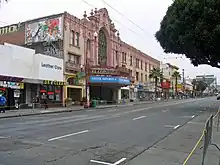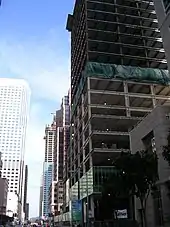 Mission Street between 19th and 20th | |
| Part of | |
|---|---|
| Namesake | Mission Dolores |
| Maintained by | City of Daly City San Francisco Department of Public Works |
| Nearest metro station | |
| South end | |
| Major junctions | |
| North end | The Embarcadero in San Francisco |
Mission Street is a north-south arterial thoroughfare in Daly City and San Francisco, California that runs from Daly City's southern border to San Francisco's northeast waterfront. The street and San Francisco's Mission District through which it runs were named for the Spanish Mission Dolores, several blocks away from the modern route. Only the southern half is historically part of El Camino Real, which connected the missions. Part of Mission Street in Daly City is signed as part of State Route 82 (SR 82).
Alignment

From the south, Mission Street begins as a continuation of SR 82/El Camino Real at the Colma-Daly City border, just south of San Pedro Road. Mission Street then runs north to the Top of the Hill district, where SR 82 splits as San Jose Avenue to the northeast, and Mission Street continues north-northeast. It then crosses the San Francisco city limits mid-block between Templeton Avenue in Daly City and Huron Avenue in San Francisco. Mission Street then turns back northeast through the working-class Crocker-Amazon, Excelsior, and Bernal Heights neighborhoods, before turning north through the colorful Outer Mission and Inner Mission districts.[1] Near Van Ness Avenue, the road turns northeast again and travels through Mid-Market and South of Market (running parallel to, and a full block south of Market Street) before ending at The Embarcadero in downtown San Francisco.[2]
History

Mission Bay and Mission Dolores were connected to the former village of Yerba Buena, in the northeastern corner of modern San Francisco, via the Mission Plank Road, a 3.25-mile (5.23 km) long toll road extending from Kearny/Third to Fifteenth. The franchise for the Mission Plank Road was granted in November 1850 and the Plank Road was completed by the following Spring at a cost of US$96,000 (equivalent to $3,377,000 in 2022); tolls were 50 cents for a horse and cart, and one dollar for a four-horse team. The Mission alignment was selected because Market had a high ridge between Second and Fifth; although a cut was still required for Mission, it was less extensive. The Plank Road used a bridge to cross a swamp at Mission and Seventh; the bridge was intended to rest on piles, but piles were sunk to 80 feet (24 m) deep without reaching bottom, so a floating bridge was used instead. A parallel plank road was completed along Folsom Street to stave off potential competition from a free road along Market; however, a high tide in 1854 destroyed the Folsom Plank Road by floating off the planks.[3]
Since 2000, between Third Street and Beale Street in the Financial District, several new high rises have been erected along Mission Street, all in the vicinity of the San Francisco Transbay development project: 101 Second Street (2000), JPMorgan Chase Building (2002), The Paramount (2002), St. Regis Museum Tower (2005), 555 Mission Street (2008), Millennium Tower (2009), 535 Mission Street (2014), 350 Mission Street (2015), and the Salesforce Tower (2017).
Transportation
The Mission Street portion in San Francisco is served 24 hours per day by the San Francisco Municipal Railway 14 Mission trolleybus, two BART stations that run below grade in the Inner Mission, and the remainder of the San Francisco BART stations less than a half mile away, notably including those on the Market Street subway. The street is four lanes wide.[4]
The Transbay Transit Center, which replaced the Transbay Terminal, straddles several blocks between Mission and Howard. It is the western terminus for several AC Transit bus lines via the San Francisco–Oakland Bay Bridge, and it will be the future northern terminus of Caltrain and the California High-Speed Rail Authority. From the completion of the Bay Bridge in 1936 until the 1950s, it was also the western terminus for Key System commuter rail service.
Major intersections
| County | Location | mi | km | Destinations | Notes |
|---|---|---|---|---|---|
| San Mateo | Colma–Daly City line | South end of Mission Street; south end of SR 82 overlap; continuation into Colma | |||
| Daly City | John Daly Boulevard, Hillside Boulevard | ||||
| North end of SR 82 overlap | |||||
| Templeton Avenue | Daly City city limits terminus mid-block | ||||
| City and County of San Francisco | Huron Avenue | San Francisco city limits terminus mid-block | |||
| Interchange; no entrance ramps; south end of US 101 north overlap | |||||
| North end of US 101 north overlap | |||||
| The Embarcadero | North end of Mission Street; former SR 480 | ||||
1.000 mi = 1.609 km; 1.000 km = 0.621 mi
| |||||
References
- ↑ "San Francisco's Mission Districts". Via Magazine. March 2003. Retrieved 2010-02-01.
- ↑ Carl Nolte (November 26, 2016). "A trip down Mission, the most San Franciscan of streets". San Francisco Chronicle. Retrieved 2018-10-12.
- ↑ Hittell, John Shertzer (1878). "IV. The Golden Era, § 73. Plank Road". A history of the city of San Francisco; and incidentally of the state of California. San Francisco: A. L. Bancroft & Company. pp. 151–153. Retrieved 14 January 2020.
- ↑ "Route description of 14 Mission". San Francisco Municipal Transportation Agency. 2011. Archived from the original on 2012-09-18. Retrieved 21 February 2011.
External links
 Media related to Mission Street at Wikimedia Commons
Media related to Mission Street at Wikimedia Commons
